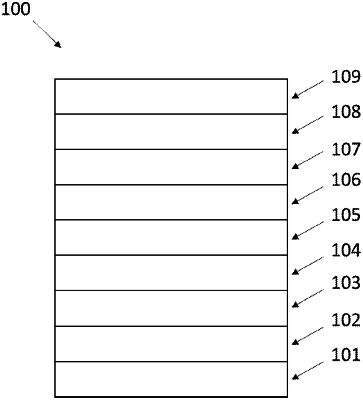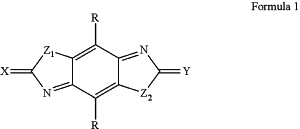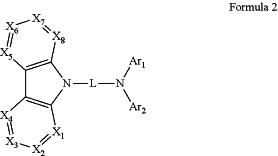| CPC H10K 85/6572 (2023.02) [H10K 85/631 (2023.02); H10K 50/155 (2023.02)] | 21 Claims |

|
1. An organic electroluminescence device, comprising:
an anode,
a cathode,
a light-emitting layer disposed between the anode and the cathode, and
a first organic layer disposed between the anode and the light-emitting layer,
wherein the first organic layer comprises a compound of Formula 1 and a compound of Formula 2;
 wherein, in Formula 1,
X and Y are, at each occurrence identically or differently, selected from NR′, CR″R′″, O, S or Se;
Z1 and Z2 are, at each occurrence identically or differently, selected from O, S or Se;
R, R′, R″ and R″' are, at each occurrence identically or differently, selected from a group consisting of: hydrogen, deuterium, halogen, a nitroso group, a nitro group, an acyl group, a carbonyl group, a carboxylic acid group, an ester group, a cyano group, an isocyano group, SCN, OCN, SF5, a boryl group, a sulfinyl group, a sulfonyl group, a phosphoroso group, a substituted or unsubstituted alkyl group having 1 to 20 carbon atoms, a substituted or unsubstituted cycloalkyl group having 3 to 20 ring carbon atoms, a substituted or unsubstituted heteroalkyl group having 1 to 20 carbon atoms, a substituted or unsubstituted arylalkyl group having 7 to 30 carbon atoms, a substituted or unsubstituted alkoxy group having 1 to 20 carbon atoms, a substituted or unsubstituted aryloxy group having 6 to 30 carbon atoms, a substituted or unsubstituted alkenyl group having 2 to 20 carbon atoms, a substituted or unsubstituted alkynyl group having 2 to 20 carbon atoms, a substituted or unsubstituted aryl group having 6 to 30 carbon atoms, a substituted or unsubstituted heteroaryl group having 3 to 30 carbon atoms, a substituted or unsubstituted alkylsilyl group having 3 to 20 carbon atoms, a substituted or unsubstituted arylsilyl group having 6 to 20 carbon atoms, and combinations thereof;
each R is identical or different, and at least one of R, R′, R″ and R′″ is a group having at least one electron-withdrawing group; and
in Formula 1, adjacent substituents are optionally joined to form a ring;
wherein, in Formula 2,
 X1 to X8 are, at each occurrence identically or differently, selected from CR1 or N;
L is, at each occurrence identically or differently, selected from a substituted or unsubstituted arylene group having 6 to 30 carbon atoms, a substituted or unsubstituted heteroarylene group having 3 to 30 carbon atoms, or combinations thereof;
Ar1 and Ar2 are, at each occurrence identically or differently, selected from a substituted or unsubstituted aryl group having 6 to 30 carbon atoms or a substituted or unsubstituted heteroaryl group having 3 to 30 carbon atoms;
R1 is, at each occurrence identically or differently, selected from a group consisting of:
hydrogen, deuterium, halogen, a substituted or unsubstituted alkyl group having 1 to 20 carbon atoms, a substituted or unsubstituted cycloalkyl group having 3 to 20 ring carbon atoms, a substituted or unsubstituted heteroalkyl group having 1 to 20 carbon atoms, a substituted or unsubstituted arylalkyl group having 7 to 30 carbon atoms, a substituted or unsubstituted alkoxy group having 1 to 20 carbon atoms, a substituted or unsubstituted aryloxy group having 6 to 30 carbon atoms, a substituted or unsubstituted alkenyl group having 2 to 20 carbon atoms, a substituted or unsubstituted aryl group having 6 to 30 carbon atoms, a substituted or unsubstituted heteroaryl group having 3 to 30 carbon atoms, a substituted or unsubstituted alkylsilyl group having 3 to 20 carbon atoms, a substituted or unsubstituted arylsilyl group having 6 to 20 carbon atoms, a substituted or unsubstituted amino group having 0 to 20 carbon atoms, an acyl group, a carbonyl group, a carboxylic acid group, an ester group, a nitrile group, an isonitrile group, a sulfanyl group, a sulfinyl group, a sulfonyl group, a phosphino group, and combinations thereof; and
in Formula 2, adjacent substituents are optionally joined to form a ring.
|